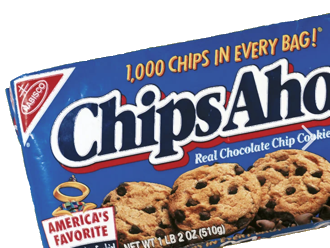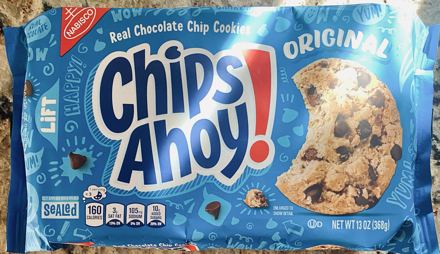Chocolate Chip Cookie Challenges
Questioning is the foundation of all learning.
The first step in rejecting not knowing is to ask, why?
Sweetland
Overview
Two challenges or investigations.
One how many chocolate chips in a package?
Does a crumbled cookie weigh the same as the uncrumbled cookie?
How many chocolate chips in a package?
Introduction:
When I created this activity the Ahoy chocolate chip packages and TV ads claimed there were 1,000 chocolate chips in every package.

Today the package doesn't.

Therefore, your introduction to the challenge might be:
How many chocolate chips are in a package of Chips Ahoy cookies?
Or
When I was a kid Chips Ahoy advertised that their cookies had 1,000 chips in every bag.
Today they don't, but do you think there still is? How can we find out how many chocolate chips are in a package without counting all the chips.
Show learners a bag of chocolate chip cookies and challenge them to determine to develop a plan to find how many chocolate chips are in the package of cookies and how they will be able to support their answer for the challenge.
Might want to provide the following restrictions. They are not allowed to sample every cookie in the bag. They will record their plan for a solution on paper and present it to the class along with their reasons why they think it will be fairly reliable.
Supporting Information
- The number of chips in a bag is a product of the number of chips in a cookie and the number of cookies in a bag.
- Multiplication is repeated addition.
- The number of chips in a package is equal to the sum of chips in all the cookies.
- An estimated number of chips is equal to the product of the mean number of chips in a cookie and the number of cookies in the bag.
- There is a mean number of chips in a cookie.
- Samples of a data set can be used to make predictions of a total set.
- A random selection has an equal number of chances of being selected as all other possible samples.
- A cookie is a random selection.
- Estimation can be done by visualizing parts of the whole and multiplying.
Learner's views
- Every cookie has a very different amount of chocolate chips.
- Half a cookie will have less than half as many chocolate chips.
- Cookies in the center of the bag do not need to be counted.
Materials: One bag of chocolate chip cookies, paper plates, tweezers, a small finishing nail or other tool to probe the cookies for chips, marking pens, transparency, and calculators.
Procedure
Exploration
- Put the learners into groups of two or three.
- Show them a bag of chocolate chip cookies and challenge them to brainstorm ways to determine the number of chocolate chips in the bags is actually 1000 if each group was given only one cookie. Time limit six minutes.
- Organize the exploration so each group will have access to the materials needed.
- Have each group use a method to determine the number of chocolate chips, illustrate their method of arriving at their answer and prepare to share their reasoning.
Invention
- Have students share their solutions and illustrations.
- Have students discuss and ask questions.
- Have them find similarities and differences with solutions.
Discovery
Have learners create a research question for an investigation that would use random sampling. Example: How many Chevy trucks pass a certain corner in a year? How many banana seeds in a banana?
Cookie crumble challenge
Learner's views
Possible reasoning - In three categories
Category 1
- The whole cookie is bigger than a broken cookie. Therefore, A whole cookie is heavier than the crumbs.
- The whole cookie is thicker. Therefore, the whole cookie holds together more to make it heavy.
- There isn't as much cookie when it is just pieces. Therefore, the pieces weigh less than the whole cookie.
Category 2
- There are more pieces to weigh than a cookie by itself. Therefore, A the pieces are heavier.
- The pieces are spread out and warm. Therefore, ...
- There is air between the pieces when you weigh it. Therefore, A the pieces are lighter.
Category 2
- It's pieces of the whole thing. Therefore, it's the same.
- It's the same stuff just different shapes. Therefore, it's the same.
- It didn't lose anything when it broke up. Therefore, it's the same.
Materials: Cookies to crumble, paper plates, or bags.
Procedure
Ask. Does the weight of a cookie change if it is crumbled?
Cookie crumble challenge.
If we Crumbled cookie how will you answer the following three questions?
- Does the whole cookie weigh more than all of the cookie crumbs from a crumbled cookie?
- Do the cookie crumbs weigh more than the whole cookie?
- Does the whole cookie and all the cookie crumbs weigh the same?
Weigh a cookie before and after crumbling.
If learners are worried about loosing or missing crumbled pieces, could put a cookie in a bag and weigh it before and after crumbling.
Discuss the results and use the three categories to ask questions and have the learners explain reasoning for and against the possibilities.